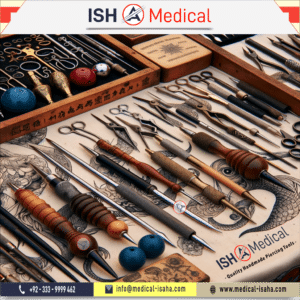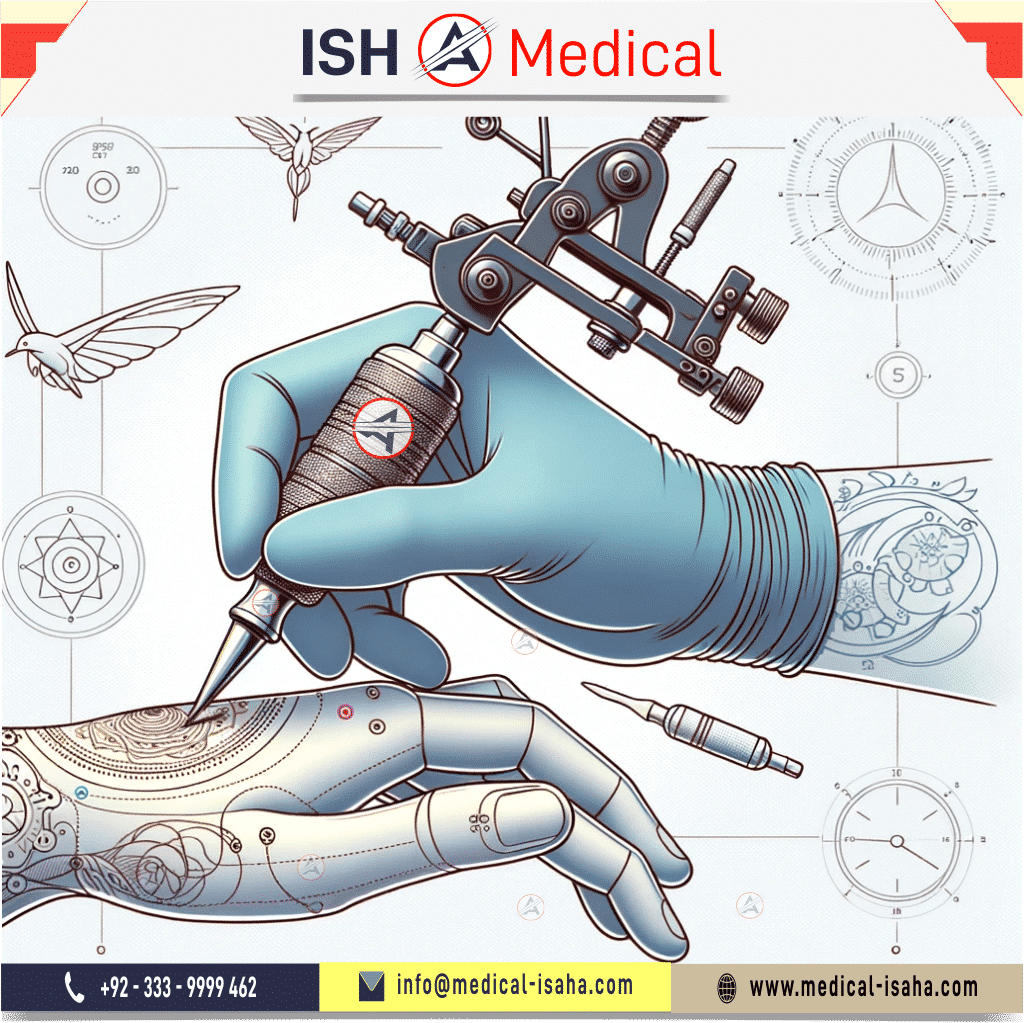What is body piercing and tattooing?
Body piercing and tattooing are popular forms of self-expression that various cultures worldwide have practiced for thousands of years. Today, they are a popular way for individuals to express themselves and showcase their individuality. Further, all of these are accomplished with the help of body piercing-tattooing handmade tools.
Body piercing involves creating a hole in a part of the body to insert jewelry. Common types of body piercings include ear piercings, nose piercings, and belly button piercings. The tools used for body piercing typically include a piercing gun or a needle. Piercing guns are most commonly used for ear piercings, while needles are used for other types of body piercings. It is essential to ensure that the tools used for body piercing are sterilized to prevent infection.
On the other hand, when you get a tattoo, you inject ink into your skin to make a design that will last forever. Tattoo artists use a tattoo machine, which includes a needle that moves up and down to inject the ink into the skin. The artist uses different kinds of ink and various methods to make the design. Like body piercing tools, it is crucial to ensure that the tattooing tools are sterilized to prevent infection.
Whether you are considering getting a body piercing or a tattoo, it is essential to research and find a reputable professional who uses sterilized tools and follows proper hygiene practices.
Handmade Body Piercing and Tattooing Tools: A Glimpse into Tradition
Body piercing and tattooing are ancient arts that have evolved over millennia. While modern methods have introduced machines and standardized tools, there’s a rich history of handmade tools that many artists still prefer. Let’s dive into the world of handmade body piercing and tattooing tools.
The Charm of Handmade Tools
Handmade tools carry the essence of tradition, craftsmanship, and authenticity. Most of the time, artists make them themselves or get them from people who make tools specifically for these arts. These tools are a testament to the dedication of the artists and the respect they have for their craft.
Hand-Poked Tattoos: The Ancient Art
Before the invention of the tattoo machine, tattoos were applied using the hand-poked method. Artists would use a sharp point, often a bone or metal, attached to a handle. The ink would be applied manually, dot by dot, into the skin. This technique requires immense patience and precision.
Traditional Piercing Needles
Handmade piercing needles, often crafted from bone, wood, or metal, have been used for centuries. These needles are typically thicker and have a blunt end, which is sharpened to perfection by the artist. Such tools reflect the traditional methods of body piercing in ancient cultures.
The Importance of Sterilization
While handmade tools bring a touch of authenticity and tradition, it’s crucial to ensure they are correctly sterilized. Further, artists who use handmade tools often have unique methods to ensure their tools are clean and safe for use, from boiling to using natural disinfectants.
Supporting Artists and Craftsmanship
By choosing an artist who uses handmade tools, you’re not just getting a piercing or tattoo; you’re supporting a tradition, an art, and the dedication of artisans. It’s an experience that connects you to the roots of the art.
Handmade Body Piercing and Tattooing Tools:
Types and Uses

-
Mosquito Hemostat Forceps
These are small, delicate forceps used primarily to hold soft tissues. With their fine-tipped ends, they are perfect for gripping tiny jewelry pieces during the piercing process.
-
Pennington Slotted Forceps
Designed with a slot at the tip, Pennington Slotted Forceps are essential for tongue piercings. They hold the tongue securely, ensuring accuracy and minimizing discomfort during the piercing process.
-
Septum Forceps
Septum forceps are designed explicitly for septum piercings. These forceps have a rounded end to grip the septum, ensuring precision during the procedure comfortably.
-
Forester (Sponge) Forceps
These forceps, commonly known as Sponge Forceps, have a rounded grip. They’re used to hold sponges and swabs for cleaning and prepping the area before piercing.
-
Ring Opening and Closing Pliers
As the names suggest, these tools are crucial for opening and closing jewelry rings. The Ring Opening Plier helps in expanding the ring, while the Ring Closing Plier is used to secure the ring after insertion.
-
Needle Holding Pliers
Designed to hold needles securely, these pliers ensure that the piercing process is smooth, steady, and precise.
-
Tweezers
A versatile tool, tweezers are used for picking up and placing small jewelry pieces, as well as for cleaning and prepping the piercing area.
-
Scissors: Iris, Operating, and Suture
Commonly used scissors during the piercing procedure are as follows:
Iris Scissors: Small and sharp, ideal for detailed work.
Operating Scissors: Used for cutting thicker materials or tissues.
Suture Scissors: Designed with a hook-like tip to cut sutures easily.
-
Body Piercing Taper
This tool helps stretch the piercing hole to accommodate jewelry, especially when inserting tunnel or plug jewelry.
-
Scalpel Handles and Blades
They are used in more advanced body modifications, and scalpels make precise incisions. They come with replaceable blades to ensure sharpness.
-
Piercing Tattoo Kidney Tray
An essential for any tattoo or piercing artist, this tray holds all the tools, ensuring they’re easily accessible and kept sterile.
Handmade tools in body art are a testament to the meticulous nature of the craft. Each tool, designed with specific purposes in mind, ensures that the artist can work with precision, care, and passion.
Selecting Handmade Body Piercing and Tattooing Tools:
A Comprehensive Guide
Body art is not just a form of expression; it’s a commitment to an artwork that will stay with you. In any art, the tools used are essential to the end result. In the realm of body piercing and tattooing, the importance of selecting the right tools cannot be overstated. If you’re considering delving into this world, either as an artist or an enthusiast, here’s a guide to help you choose the best handmade tools.
Understand the Craft
Before investing in tools, take the time to understand the intricacies of piercing and tattooing. Research, attend workshops, or even apprentice under a professional. This foundation will guide your tool selection.
Quality Over Quantity
It might be tempting to buy a comprehensive set of tools, but it’s wiser to invest in fewer, high-quality pieces. A well-made tool can enhance precision and reduce the chances of complications.
Brand Matters: Spotlight on ISAHA Medical
Numerous brands are in the market, but not all are created equal. One brand that stands out for its commitment to quality and craftsmanship is ISAHA Medical. Their tools are crafted with care, ensuring durability and precision. When investing in tools, look for brands like ISAHA Medical with an excellent reputation.
Ergonomics and Comfort
A tool might be of high quality, but if it’s uncomfortable to hold and use, it can affect the outcome. Also, look for tools that fit well in your hand, are not too heavy, and provide a good grip.
Material and Sterilization
The material of the tools is crucial. Opt for stainless steel or titanium tools, which are durable and can be sterilized effectively. Sterilization is paramount in body art to prevent infections.
Versatility
While specialized tools are essential for specific tasks, look for tools that can be used for multiple purposes. Also, this not only saves money but also reduces the clutter in your workspace.
Read Reviews and Seek Recommendations
Before making a purchase, read reviews from other professionals in the field. In the same way, personal recommendations can also guide you towards trusted brands and tools.
Budget Wisely
While it’s essential to invest in quality, it’s equally important to budget wisely. High quality can mean something other than expensive. Compare prices, look for deals, and shop around, but make sure to pay attention to quality.
Also, choosing the right tools is a significant step in your journey as a body art professional or enthusiast. It can make the difference between a mediocre and a masterpiece outcome. Remember, in the world of body art, precision, safety, and quality are paramount. Finally, choose wisely, and your tools will serve you well for years to come.
